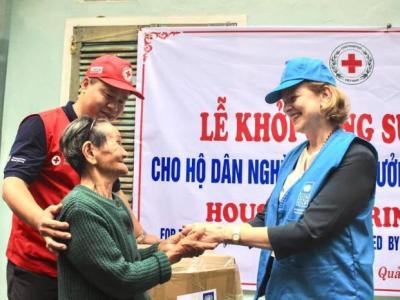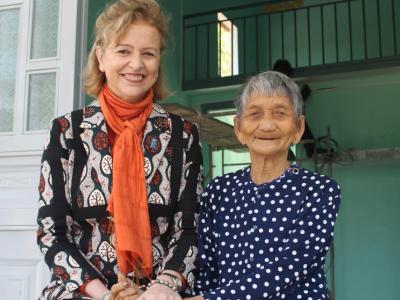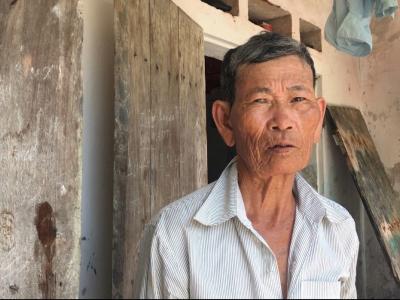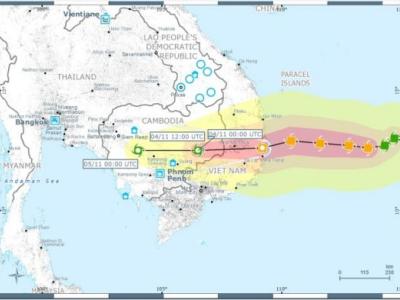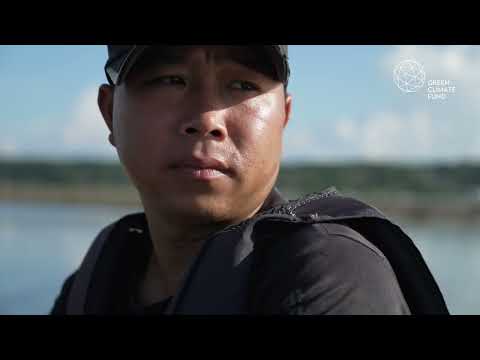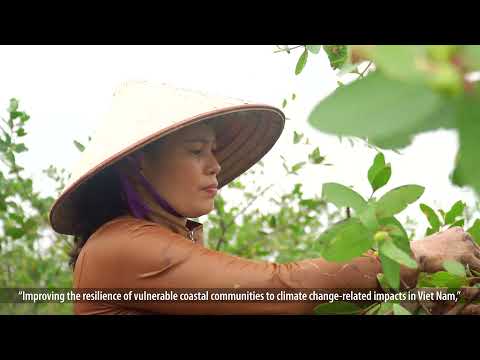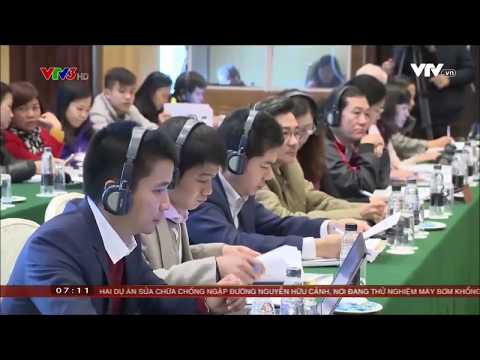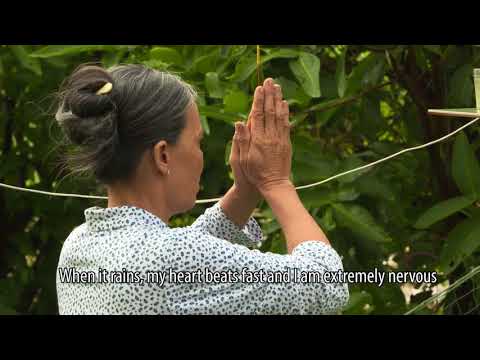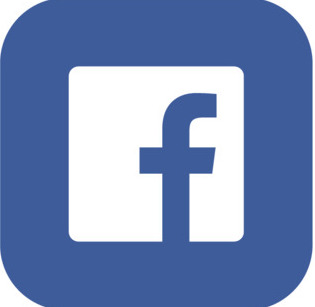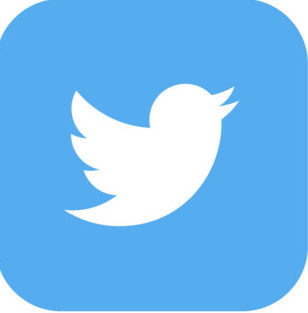
Photo:
The project Improving Resilience of Vulnerable Coastal Communities to Climate Change in Viet Nam (2017-2024) focused on increasing the resilience of vulnerable coastal communities to climate change, scaling-up already-tested interventions.
Building on ongoing social protection programmes related to housing for the poor and marginalized, the project incorporated storm and flood resilient design features in new houses, benefiting 20,000 poor and highly disaster-exposed people. As part of an integrated response to managing flood risks, more than 4,000 hectares of mangroves were rehabilitated and/or planted to function not only as storm surge buffers, but also to provide ecosystem resources that can support coastal livelihoods.
To support and sustain the impacts of this project - as well as future requisite government policy adjustments that strengthen the resilience of coastal and other communities - climate and economic risk assessments for private and public sector application were systematized in all 28 coastal provinces of the country.
- Community
- District
- National
- Country Office
- National Governments
30 million coastal residents will benefit from improved planning integrating climate risk information, 20,000 people will benefit from climate-resilient housing, and 3,8 million people in the target coastal provinces will benefit from the protection offered by healthy and robust mangrove regeneration. An estimated 1.9 million tons of carbon dioxide emissions will be avoided.
- Green Climate Fund
- United Nations Development Programme (UNDP)
- Ministry of Planning and Investment (MPI) -- Government of Viet Nam
Expected outcomes
Output1: Storm and flood resilient design features added to 4,000 new houses on safe sites, benefiting 20,000 poor and highly disaster-exposed people in 100 communes
Output 2: Regeneration of 4,000 hectares of costal mangrove storm surge buffer zones
Output 3: Increased access to enhanced climate, loss and damage data for private and public sector application in all 28 coastal provinces of Viet Nam
Poor communities living in coastal regions of Viet Nam are adversely impacted by frequent flooding. Each year approximately 60,000 houses in coastal provinces are destroyed or damaged by floods and storms. This is likely to worsen given climate change scenarios.
Resultant economic impacts make it increasingly difficult for vulnerable families to escape the cycle of poverty. With funding from the Green Climate Fund, this project will scale-up already tested interventions to increase the resilience of target communities. Building on ongoing social protection programmes related to housing for the poor and marginalized, the project will incorporate storm and flood resilient design features in new houses benefiting 20,000 poor and highly disaster-exposed people.
As part of an integrated response to managing flood risks, 4,000 hectares of mangroves will be rehabilitated and/or planted to function not only as storm surge buffers, but also to provide ecosystem resources that can support coastal livelihoods. Moreover, to support and sustain the impact of this project, as well as future requisite government policy adjustments that strengthen the resilience of coastal and other communities, the project will systematize climate and economic risk assessments for private and public sector application in all 28 coastal provinces of the country.
“Finally, we have a resilient house to protect our lives and assets” - UNP Viet Nam, September 20 2018. “My area is often flooded and we usually have to move to one of my neighbours’ houses for two or three days because they are located at a higher altitude." Ms. Nguyen Thi Mua's new resilient house is one of 85 being built under the UN Development Programme and the Green Climate Fund-supported project, ‘Improving the Resilience of Vulnerable Coastal Communities to Climate Change Related Impacts in Viet Nam’ in 2018.
'Forty storm-resilient houses presented to vulnerable families in Quang Ngai' - UNDP Viet Nam, May 5 2018. The Viet Nam Disaster Management Authority (Ministry of Agriculture and Rural Development) together with UNDP and Quang Ngai People's Committee have handed over a further 40 storm-resilient houses to poor and vulnerable households.
'Resilient houses help people change their lives' - UNDP Viet Nam, April, 2018. Ms. Nguyen Thi Mun, 77, is one of seventy-seven poor households in Quang Ngai province to receive storm-resilient housing under the GCF-supported project, “Improving resilience of vulnerable coastal communities to climate change related impacts in Viet Nam.”
'Coastal province of Quang Nam to accelerate implementation of the nation's first Green Climate Fund-financed project' - UNDP Viet Nam, March 16, 2018. Project to build 243 storm-resilient homes and restore 135 hectares of mangrove forests over next five years, boosting the resilience of thousands.
'Go inside when storm comes and go upstairs when it floods' - UNDP Viet Nam, March 1, 2018. UNDP is supporting the construction of 4,000 safe houses in five coastal provinces of Quang Ngai, Quang Nam, Quang Binh, Thua Thien Hue and Thanh Hoa over the next 4 years. One of the early recipients, Tiem, now lives in what she calls a new, ‘resilient’ home. She stores most of her furniture on the upstairs floor where she can stay safer during the flooding, and there is a big window that serves as an exit for evacuation.
'Storm-proof housing increases the resilience of vulnerable coastal communities to climate change in Viet Nam' - UNDP Viet Nam, February 13, 2018. The Viet Nam Disaster Management Authority, Ministry of Agriculture and Rural Development, and UNDP hand over storm-resilient houses to households in the province of Quang Ngai. Thirty-seven houses have been built so far, with more than 300 houses to be built in 2018.
'Shelter from the Storm: Why flood and storm resilient housing is key to sustainable development in Viet Nam' - UNDP Viet Nam, November 12, 2017. By Jenty Kirsch-Wood, UNDP Climate Change Adaptation and Resilience Specialist
Speech by Mr. Kamal Malhotra, UNDP Resident Representative in Viet Nam at the Viet Nam - Green Climate Fund Cooperation Dialogue - UNDP Viet Nam, June 26, 2017.
'Green Climate Fund announces $29.5mn project to boost Viet Nam’s climate resilience' - Tuoi Tre News, June 26, 2017. The $29.5 million project was announced during a dialogue between GCF executive director Howard Bamsey and Vietnam’s Ministry of Planning and Investment in Hanoi. Bamsey, who was on his first-ever Vietnam visit, joined local officials in discussing how the Southeast Asian country could take action to achieve climate-resilient development and green growth.
'Green Climate Fund announces project to boost Viet Nam’s climate resilience' - Nhan Dan Online, June 26, 2017. Viet Nam’s Ministry of Planning and Investment, UNDP and the Green Climate Fund announce GCF-funded project to increase the climate resilience of coastal residents.
Viet Nam GCF-funded project supports vulnerable coastal communities
Call for public consultation and review of the Environmental and Social Management Plan, UNDP, April 29, 2016.
Output 1: Storm and flood resilient design features added to 4,000 new houses on safe sites, benefiting 20,000 poor and highly disaster-exposed people in 100 communes
- In the flood and typhoon prone areas of coastal of Viet Nam. This project will provide for the additional cost of safety features and improved monitoring (approximately US$2,000/house), to 4,000 houses constructed under the broader government housing programming benefitting the poor. Specifically these include (a) a concrete roof with strengthened bracings and fittings (US$900), (b) reinforced windows, doors and sealing (US$400) (c) improvements to drainage, siting and raising plinths (US$400) and (d) improved monitoring to ensure that the finished product is one that reflects all of the resilience features of the house design (US$300). This will be fully coordinated with the government housing programme, and grant support to beneficiaries will follow the government’s monitoring and disbursement schedule.
- Risk assessments will be conducted through the established CBDRM mechanism, to ensure that house siting is on a safe location. Links will be made to existing information such as the storm surge maps generated by the Disaster Management Center.
- The 100 target communes selected for this work will serve as learning hubs for broader dissemination in adjacent communes and provinces. Selection of communes and households to receive support will follow existing government criteria. Criteria and prioritization criteria are further detailed in Annex II: Feasibility Study.
- Training on engineering innovations for flood and storm resistant housing technologies, and to deliver hands-on advice and guidance to local authorities and affected households on safe and affordable house designs and construction.
Output 2: Regeneration of 4,000 hectares of coastal mangrove storm surge buffer zones using successful evidence-based approaches
- This project will support regeneration of approximately 4,000 hectares of mangroves, in coastal areas vulnerable to climate change impacts. This project will enable scale up of good practices from various pilots and integrate field proven best practices. Supplementary funds will allow for the application of improved planting and maintenance technologies outlined above, and implement the measures to ensure that livelihoods are maintained (such as relocating communal shrimp ponds to where the pressures on the mangrove stands will be minimized and the shrimp production can be well maintained).
- Specific sites within the province for project intervention will be identified/assessed through various criteria, namely (a) exposure to climate change induced events (i.e. typhoons, storm surges, sea level rise, coastal flooding), (b) potential for mangrove restoration, and (c) complementarity with ongoing government or partner support to maximize the impact of combined resources. Regeneration and rehabilitation efforts will be implemented in phases. While the techniques to be used are based on best practices of previous mangrove rehabilitation efforts, a phased approach will allow time for further monitoring and assessment of techniques, as well as review of risk mitigation measures. Adjustments will be made as needed to maximize the survival rate.
- Target communes will set up a community committee incorporating both local government and a cross-section of residents to complete a CBDRM risk assessment and planning process. Additional sessions on coastal mapping, mangrove regeneration and livelihoods maintenance will be added. The community CBDRM plans will therefore include location specific actions to support implementation and maintenance of the mangroves. The project will then roll out mangrove regeneration actions to enable application of improved techniques to increase survival rates. This will be community driven process as part of the commune planning and implementation using the CBDRM process for community mobilization and engagement.
Output 3: Increased access to enhanced climate, loss and damage data for private and public sector application in all 28 coastal provinces of Viet Nam
- MARD with assistance of UNDP has worked to establish the first natural disaster loss and damage database, strengthening early warning system design and meteorological service capacity. MONRE with assistance of UNDP has strengthened climate change data and analysis and has completed the Special Report on Extreme Events (SREX) submitted to the IPCC in 2014. The government has recently developed Viet Nam’s first coastal storm surge maps to improve coastal inundation mapping.
- MARD and MONRE will make improved information more accessible to government decision makers especially at the sub-national level, on-going national programs and the private sector. This will be done by developing integrated risk maps at the sub-national level using the established methodology that Viet Nam has already been applied to produce maps in 20 out of 63 provinces. Viet Nam will be able to produce risk mapping of the entire coastal area, combing local level knowledge with the best scientific data. Data quality will also be improved by including super-storm and storm surge data based on 2014-2015 models and more accurate sea level rise projections included in the fifth IPCC assessment report. Additional analysis of salt water intrusion zones using new satellite based technology will also be included. Although this data has been developed, or is near finalization, it is not currently being systematically applied by the government at any level. This would be a transformative change in Viet Nam’s ability to analyze and compare climate change risks in coastal areas.
- UNDPKeti ChachibaiaRegional Technical Adviser, Climate Change Adaptation






